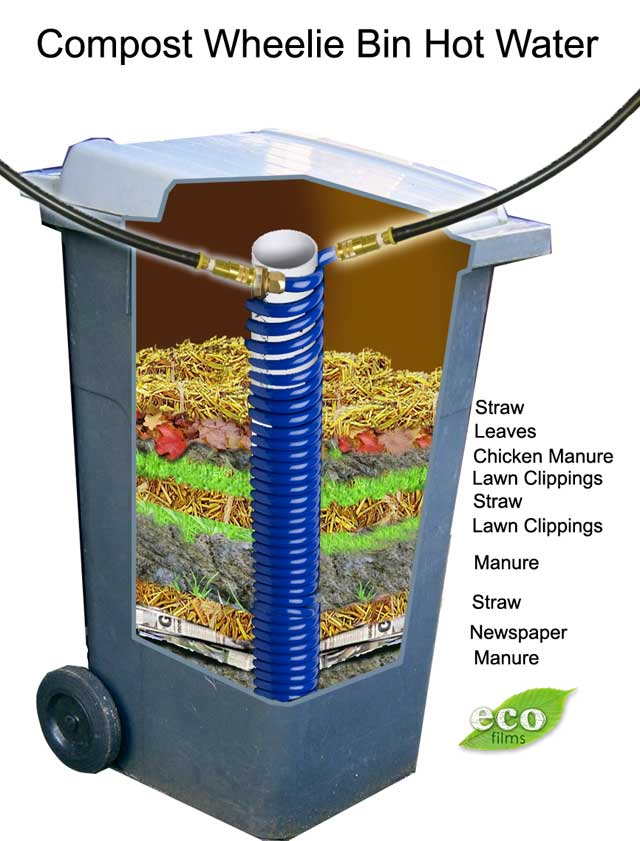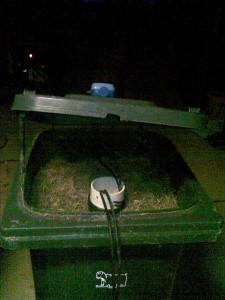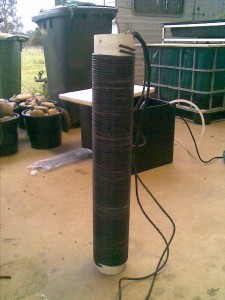Here’s a great tip given by a member of the Aquaponics Made Easy Forum on cheap easy to build hot water system using compost.
The original question posted to the forum was how to heat a fish tank over winter without any extra energy costs. A hard thing to do. Thermal Mass heating was one answer but a crafty member posted a very interesting solution and swears that it works a treat. We’ve illustrated his simple design.
So simple you will think “Aha! Why didn’t I think of that?”
The original question posted to the forum was how to heat a fish tank over winter without any extra energy costs. A hard thing to do. Thermal Mass heating was one answer but a crafty member posted a very interesting solution and swears that it works a treat. We’ve illustrated his simple design.
So simple you will think “Aha! Why didn’t I think of that?”
Daryl from Windsor in NSW came up with an innovative solution using two ordinary wheelie bins that are filled with compost and a wound central pipe arrangement to turn cold water hot very quickly. How does it work?
“What I have made is a compost heater, inside a wheelie bin with 20 mm poly pipe coiled around
the inside wall of a pipe – about 8 metres in each bin.” he says.
the inside wall of a pipe – about 8 metres in each bin.” he says.
Compost can reach a core temperature of 70 degrees Centigrade. Conventional Hot Water systems are thermostatically set to heat the water to around 65 – 70 degrees centigrade. So at it’s peak this system will create very hot water for free.
“Then I load the first wheelie bin with grass clippings and horse manure after two weeks load the second
wheelie bin with the same stuff. After four weeks I empty and reload the first bin. You can leave the system running longer but the main heat production is in the first four weeks.” says Daryl.
wheelie bin with the same stuff. After four weeks I empty and reload the first bin. You can leave the system running longer but the main heat production is in the first four weeks.” says Daryl.
Sourcing a wheelie bin in the city is quite easy. The main ingredients are Nitrogen and Carbon.
Any green leafy material like fresh grass clippings is suitable as a nitrogen source.
When mixed with an alternating layer of carbon such as dry leaves, shredded newspapers or cardboard the end result is ignited by micro organisms to create compost.
Any green leafy material like fresh grass clippings is suitable as a nitrogen source.
When mixed with an alternating layer of carbon such as dry leaves, shredded newspapers or cardboard the end result is ignited by micro organisms to create compost.
Make sure the mixture is well watered as a dry mix will not work so well.
But harnessing the heat given off in the core of the wheelie bin is where this idea really shines.
The central vertical pipe could also benefit with a number of large size holes drilled into it to assist oxygenation of the compost heap core without turning the heap over as is the case with most conventional compost systems.
Daryl says you can enjoy quite a number of free hot showers before the system will eventually cool down and advocates a rich grass mixture.
But harnessing the heat given off in the core of the wheelie bin is where this idea really shines.
The central vertical pipe could also benefit with a number of large size holes drilled into it to assist oxygenation of the compost heap core without turning the heap over as is the case with most conventional compost systems.
“If the grass is packed in tight it should hit peak temp in about a week and hold for about 3 weeks then start tapering off.”
“Its best if you can have a second bin started and just swap from one to the other, you can use other stuff in the bin like a normal compost heap but because the grass has so much nitrogen in it it’s start up time is much faster.”
“A few years ago I helped build a large compost heap that had about 300 meters of 25mm rural pipe going through it.”
“After 4 weeks this system was providing enough hot water for 35 people to wash up and shower with.”
“I was there for 3 months and we kept adding compost onto the heap and it worked the whole time I was there, eventually you would have to dig out the pipe, use the compost, and start all over again. That’s why I used the wheelie bins” said Daryl.
The end result is an endless supply of rich garden compost and lots of free hot water!




I struggle to get my compost warm enough to kill the weed seeds so surely this would make that even more of a problem?
ReplyDeleteThanks Anonymous - Try the steps above and you should achieve a hot, thermophillic compost heap. Also, watch this video:
ReplyDeletehttp://permacultureideas.blogspot.com/2010/07/making-thermophillic-compost-heap-part.html
If you have further questions, feel free to get in touch!
Wow, that's really a cheap easy way to build hot water system and at the same time make a compost for garden. Great stuff!!
ReplyDelete